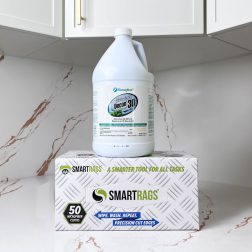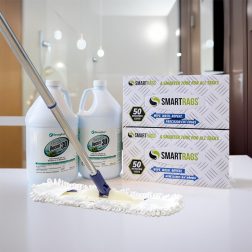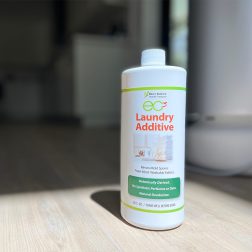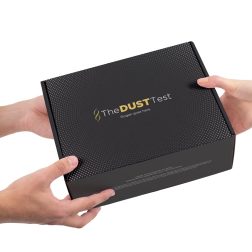No products in the cart.
Mold Resources
Knowing how to deal with mold in air vents and determine if it’s a problem in the first place is a phenomenal piece of awareness to have to help keep your home healthy. With that in mind, here’s what you need to know.
How Does Mold Get in the Air Vents?
Mold exists relatively everywhere on the planet. Colonies reproduce by aerosolizing spores, which travel through the air and remain dormant, non-living particles until they land somewhere with all the conditions they need to develop into living organisms. These conditions typically include just food and water. That brings us to the HVAC system and finding the answer to “How does mold get in the air vents?”
Thanks to their small size, these airborne spores can blow into your home and easily enter your home’s HVAC system. The key, then, is to understand where those life-giving sources of moisture and organic matter come from.
There are several potential moisture sources for mold in an HVAC system. Some are an unavoidable function of the system, and some might be caused by an incorrect system design.
Humidity is a source of moisture that often allows mold to grow. Properly designed HVAC systems pull a sufficient amount of moisture from the air and reduce indoor humidity levels. A correctly designed system should also support proper airflow throughout a home. If airflow is not adequately regulated by an HVAC system, pockets of stagnant air can form, and humidity levels can increase both within the living areas of a home and within the HVAC system and ducting itself. Gaps in improperly sealed ductwork can also allow moisture to penetrate a system from elsewhere in your home. These all lead to mold being opportunistically able to grow.
HVAC systems themselves can also generate moisture. The moisture they pull out of the air has to go somewhere in the system. If the places it goes are not properly maintained, mold in air vents can occur. Drain pans and condensate drain lines will provide a constant source of water and should be regularly cleaned and maintained to ensure proper function and avoid moisture buildup. The evaporator coils, the part of an HVAC that draws heat and moisture out of the air, will also produce condensation. When coils become coated in dust that makes its way into the system from your home, it can become the ideal breeding ground. That brings us to the final piece of the puzzle, the food source for mold in an HVAC system.
Dust is packed full of organic materials for mold to consume and grow. Dead skin cells, dander, pollen, oils, fabric particles, and more can all be found in dust and serve as the perfect food source for mold. When your HVAC system intakes this dust and comes in contact with a high-moisture area, like the evaporator coil, mold in air vents can occur.
What Causes Black Mold in Air Vents?
Black mold typically refers to Stachybotrys chartarum. This species of mold requires high levels of moisture to grow. If there are areas of the HVAC system are not properly maintained and moisture collects in spaces such as the evaporator coil and drip pan, this can lead to black mold in air vents.
Signs of Mold in Air Vents
That brings us to signs of mold in air vents. First and foremost, visible growth may be noted around registers and returns or on components of the air handler unit. If you can see it, then you there’s an issue that needs to be handled. The next most obvious sign of mold in air vents is a musty, earthy, cigar-like odor from your HVAC system and vents. Water leaks or known issues with condensation accumulation also indicate a potentially suitable condition for mold growth and should be cause for concern. Poor performance from your system is also a potential sign of mold in air vents. Colonies that are growing on HVAC system components can reduce their efficiency and result in reduced cooling performance. Lastly, if you, the homeowner, are having chronic symptoms with seemingly no underlying cause, it could be a result of exposure to mold in your home, including the HVAC system.
Can Mold in Air Vents Make You Sick?
Yes, mold in air vents can make you sick due to inhalation of particles. A contaminated HVAC system will pump air packed full of mold spores, fragments, and byproducts to every part of your home that the system is designed to heat and cool. You can think of an HVAC system as the lungs of your home, bringing fresh air to your living space. If that air becomes contaminated by the system, negative health effects can develop from exposure to the poor air quality.
Exposure triggers a multi-systemic immune response, so symptoms can span the entire body. Some common symptoms include headaches, coughing, runny nose, watery eyes, rashes, mood swings, digestive issues, brain fog, chronic fatigue, and more. Everyone responds differently to mold exposure for a variety of factors. While one person may have no symptoms, another may develop over a dozen. Other issues that can develop include but are certainly not limited to, mold-induced asthma, allergic fungal sinusitis, allergic bronchopulmonary aspergillosis, and hypersensitivity pneumonitis. That’s why all microbial growth in a home should be taken seriously and dealt with quickly and correctly.
How to Test for Mold in Air Vents
If you suspect that you’re dealing with mold in air vents, here’s how to start finding answers.
First Step
To determine if there’s a problem, your best bet is to test your dust.
Gravity brings particles like mold spores, mycotoxins, and endotoxins down to horizontal surfaces like floors, doorframes, and furniture. So basically, where dust collects, so do these indoor contaminants.
Testing this dust will help to determine exactly what’s hanging out in your home and potentially causing problems. Highly contaminated dust is not only a health hazard, as all of those particles can enter the body when they’re kicked up into the air when the dust is disturbed. It also indicates that there’s an underlying contamination problem somewhere in the home.
The Dust Test is the first stop on your journey to help improve indoor air quality in your home. It will help you know if there’s a problem before spending thousands of dollars trying to find one (both medically and in your home). And, if there is a problem, The Dust Test will indicate what you’re being exposed to before your inspector comes so that you can ensure they will find where it’s coming from.
If these results show an issue, you can bring in a mold inspector to better hone in on what’s going on inside your home.
Showing the single result
What to Expect From a Mold Inspector
A qualified mold inspector sets the foundation for success in properly handling a contamination situation. All of the data they collect will help create the comprehensive protocol needed by the remediation team to appropriately handle the toxic situation.
When looking for an inspector, don’t be afraid to ask questions about their experience.
- What’s their track record?
- What training have they had?
- Are they skilled at helping hypersensitive individuals?
- What’s their process?
- What tests will they run?
- Do they have any limitations?
- Will they draft a protocol after assessing the data for the remediation team?
This will help shine a light on how seriously they take this issue and ensure that the process is thorough enough to resolve the contamination situation.
A qualified mold inspector should tick a few boxes when answering these questions. For example, a proper inspection should then take a few hours at a minimum and use a variety of methodologies.
Some of the testing data you should expect to see are:
- Species of mold present
- Quantities of each mold
- Potential spore presence in the HVAC system
- Presence of mycotoxins
- Presence of bacteria
All of this information is needed to understand what’s actually existing in the home so that they can create the right protocol for the unique situation. If other contaminants such as mycotoxins and bacteria are present, the remediation protocol will need to address this. Should spores make their way into the HVAC, this will need to be remedied. Otherwise, those particles will blow all over the home and could turn into a new mold colony.
Successful remediation requires every piece of the puzzle to fit together correctly in order to decontaminate a home.
How to Get Rid of Mold in Air Vents
Knowing who to hire for a mold inspection sets up an excellent foundation for remediation that’s successful. If the data collected by the inspector shows that there’s mold in air vents, your next step is to find a remediation team to come in and get rid of that contamination. Like mold inspectors, though, not all remediation teams are built the same.
Again, you want a company that prioritizes your health, understands the importance of creating a safe environment, and is confident that they can properly remediate the space. Make sure to ask as many questions as possible to thoroughly assess whether or not they can do the job and do it correctly. Do they have experience helping hypersensitive individuals? Are they confident they can remove mycotoxins, a toxic byproduct of some mold species? What’s their success rate like? If post-testing still shows high levels of contamination, what’s their next move?
This will give you a baseline for what to expect from the company. Another point you should look for is how thorough their remediation process is.
At its heart, a remediation team bent on success should always adhere to three pillars for success.
Remediate the sources properly.
Identify and address the problems that led to those sources in the first place.
Eradicate all contamination created by those sources, including toxins and bacteria.
Failure to hit every point can lead to failed remediation and continuing to have mold in air vents in your home. If the source that led to the contamination isn’t addressed, the conditions for growth are still there, allowing the problem to come right back. High levels of contamination left behind can lead to continued exposure. This includes mycotoxins and bacteria, which can be removed from the space. It requires a thorough decontamination process to deal with these hard-to-eliminate particles, but it is possible.
Once the remediation is complete, the mold inspector should then come back in and complete post-testing to ensure the job was done correctly. If a company does not agree with this, they are not the company for you.
Gathering this information will not only give you peace of mind knowing that they’ll do everything in their power to remediate your home, but you’ll also know that they’re in your corner fighting for a healthy home. When it comes to dealing with mold, that’s one of the most important things for winning the battle and getting rid of this fungus among us.
Tools to Prevent Mold in Air Vents
Showing all 3 results
-

Mold & Bacteria Contents Cleaning
Remove harmful pollutants that accumulate in the dust of your home. (Options available for renters...
-
$99.00 – $349.00 SHOP NOW -

HomeCleanse Cleaning
Take your cleaning to the next level buying all the tools we use to keep...
-
$299.00 – $549.00 SHOP NOW -

EC3 Laundry Additive
Add EC3 to every rinse cycle to rinse away mold, bacteria and musty odors from...
-
$23.00 SHOP NOW
Still Have Questions?
A member of our team is here to help! Click on “Get Started ➤” below to book a consultation with a member of the HOMECLEANSE team. We have a few quick questions that will help us put together a roadmap to solve or prevent all of your mold problems.
Two minutes of your time could lead to better health for you and your family.
Resources:
- The current role of Aspergillus and Penicillium in human and animal health
- Featured Mold - Aspergillus and Penicillium - Indoor Science
- Aspergillus | Mycology | University of Adelaide
- Penicillium Sp. | Viticulture and Enology
- Aspergillus and Penicillium
- Aspergillosis - Symptoms & causes - Mayo Clinic

